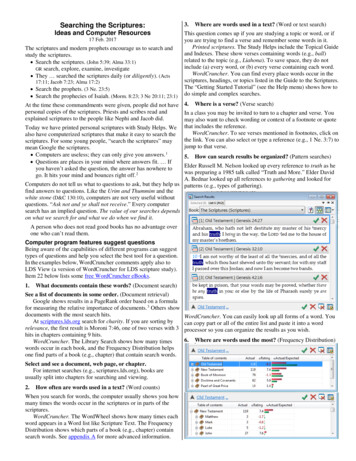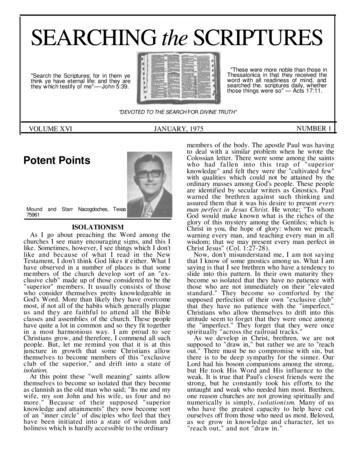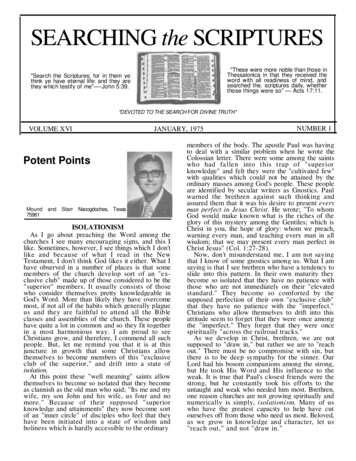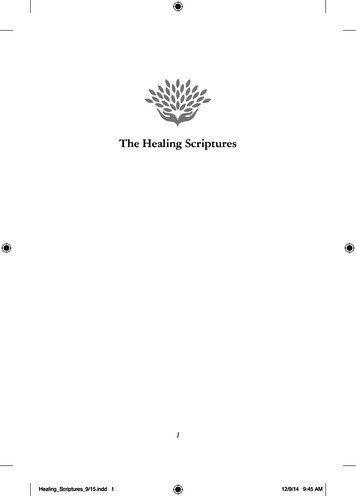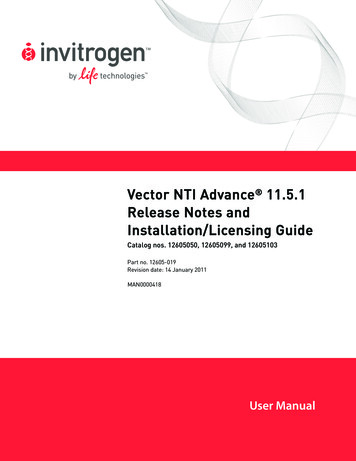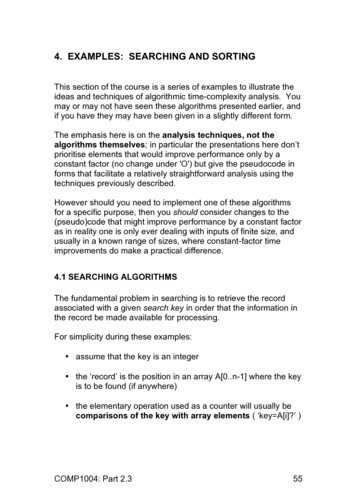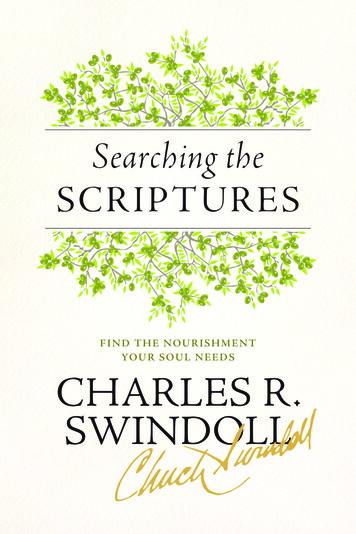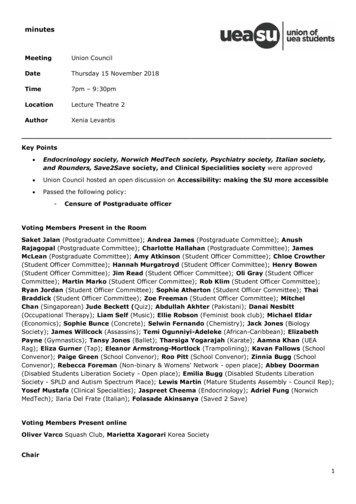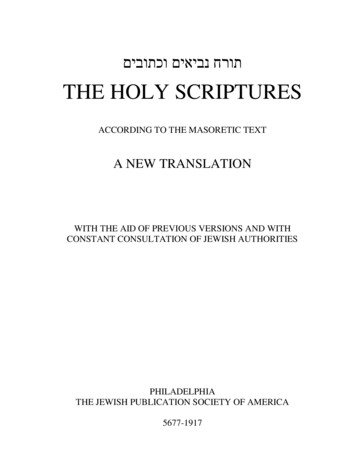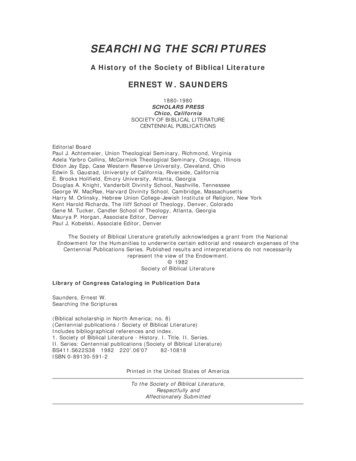
Transcription
SEARCHING THE SCRIPTURESA History of the Society of Biblical LiteratureERNEST W. SAUNDERS1880-1980SCHOLARS PRESSChico, CaliforniaSOCIETY OF BIBLICAL LITERATURECENTENNIAL PUBLICATIONSEditorial BoardPaul J. Achtemeier, Union Theological Seminary, Richmond, VirginiaAdela Yarbro Collins, McCormick Theological Seminary, Chicago, IllinoisEldon Jay Epp, Case Western Reserve University, Cleveland, OhioEdwin S. Gaustad, University of California, Riverside, CaliforniaE. Brooks Holifield, Emory University, Atlanta, GeorgiaDouglas A. Knight, Vanderbilt Divinity School, Nashville, TennesseeGeorge W. MacRae, Harvard Divinity School, Cambridge, MassachusettsHarry M. Orlinsky, Hebrew Union College-Jewish Institute of Religion, New YorkKent Harold Richards, The Iliff School of Theology, Denver, ColoradoGene M. Tucker, Candler School of Theology, Atlanta, GeorgiaMaurya P. Horgan, Associate Editor, DenverPaul J. Kobelski, Associate Editor, DenverThe Society of Biblical Literature gratefully acknowledges a grant from the NationalEndowment for the Humanities to underwrite certain editorial and research expenses of theCentennial Publications Series. Published results and interpretations do not necessarilyrepresent the view of the Endowment. 1982Society of Biblical LiteratureLibrary of Congress Cataloging in Publication DataSaunders, Ernest W.Searching the Scriptures(Biblical scholarship in North America; no. 8)(Centennial publications / Society of Biblical Literature)Includes bibliographical references and index.1. Society of Biblical Literature - History. I. Title. II. Series.II. Series: Centennial publications (Society of Biblical Literature)BS411.S622S38 1982 220'.06'0782-10818ISBN 0-89130-591-2Printed in the United States of AmericaTo the Society of Biblical Literature,Respectfully andAffectionately Submitted
ERNEST W. SAUNDERS is a well-known lecturer and writer in the fields of New Testamentliterature, its Roman-Hellenistic cultural environment, and textual criticism. He is professoremeritus of New Testament Interpretation and former dean of Garrett-Evangelical TheologicalSeminary in Evanston, Illinois.Professor Saunders has been a member of the Society of Biblical Literature for forty-oneyears. He has served as the Society's Honorary President and as a delegate to the AmericanCouncil of Learned Societies.TABLE OF .X.IN THE BEGINNING, 1880-1900THE WISDOM OF THE SCRIBE, 1900-1920A TIME TO BUILD UP, 1920-1940SHAKING THE FOUNDATIONS, 1940-1967A NEW THING, 1968-1980THE TRIBES OF THE DISPERSIONBROTHERS AND SISTERSOF THE MAKING OF BOOKSTHE VOICE OF MIRTHSIGNS AND ript Record of the Preliminary Meeting, 2 January 1880Honorary MembersSymposiums and Collaborative Research Components of Annual Meeting ProgramsRegionsEditors of the Journal of Biblical LiteratureSBL PresidentsHonorary PresidentsSBL SecretariesIllustrations1.2.3.4.5.6.A Group of Charter MembersMedallion in Memorial Window, Christ Church, Gardiner, MaineAnnouncement of the Nineteenth Meeting, 1889Announcement of the First Joint Meeting, 1894Program of the Fiftieth Anniversary, 1930Program Announcement, 1897
PREFACEThis is the story of a group of people, dedicated to teaching and research, who haveinfluenced significantly the course of American biblical scholarship for over a century. Some ofthem are well known beyond the circle of professional colleagues; others are familiar only toimmediate associates and students. Their academic discipline of critical study of the Jewishand Christian scriptures is among the oldest in the panoply of the fields of knowledge. TheirSociety ranks among the oldest of academic associations in the area of humanistic studies inNorth America. Its members are drawn from faculties of religious studies in undergraduatecolleges and universities and graduate schools of religion in the United States and Canada. Itdeclares itself to the larger community in these terms:The object of the Society is to stimulate the critical investigation of the classicalbiblical literatures, together with other related literature, by the exchange ofscholarly research both in published form and in public form. The Society endeavorsto support those disciplines and subdisciplines pertinent to the illumination of theliteratures and religion of the ancient Near Eastern and Mediterranean regions, suchas the study of ancient languages, textual criticism, history, and archaeology.The completion of the first century of service to biblical research affords occasion to reflectupon and to assess the work of the Society to date and to determine future direction. Thatpast, however, has all too often been minimized in relationship to the older and allegedlyricher contribution of European scholarship in this field. In consequence there has been onlyminor interest in that history and its impact on American culture as well as on internationalscholarship. In truth, as Roy A. Harrisville has written in his critical study of one of thepioneers in American biblical interpretation, "A man ought to know who we was before he dies.Those years of scholarly activity in this country, extending roughly from 1890 to 1940, giveidentity to many of us responsible for biblical studies here. And in many ways, those yearswere our better part - they marked an eminently fruitful period in American scholarship, and inthe opinion of some, the most fruitful to date." * Those years, enclosing Frank ChamberlainPorter's lifetime, prepared for the latest forty-year period, in which American biblical studies* Frank Chamberlain Porter, Pioneer in American Biblical Interpretation (Missoula: ScholarsPress, 1976) v, vi.xihave come of age. In the opinion of others, though, we who are alive to tell may think morehighly of ourselves than we ought.In any event, this is a biographical study of an organization, and as such it is subject to prideand prejudice, but, I hope, also to probity. The account is gleaned from many disparatesources. Prior to 1960 records are woefully sparse, especially for the first forty years. Beyondthe proceedings and papers published in the Journal, information about the period up to 1960is scattered about in the CSR Bulletin, Scholia, programs of annual meetings, mimeographedcommittee reports, minutes, budgets, secretaries' notes, and business files. The wholerepresents a cross between the Congressional Record and the New York City TelephoneDirectory. More revealing are the incidents lodged in living memories and personalcorrespondence. One friend and member wrote at the outset of this project, "Unless theanecdotal history of the SBL can be recovered, you could produce the dullest book since theBook of Chronicles." Another in a more cynical vein cautioned, "I fear that the proposedhistory will turn out to be the sort of white-washed sepulchre commonly used for suchoccasions." There are plenty of dry bones here, no doubt. One can only hope that for some, atleast, they may yet live.
Those who have contributed records and recollections to the writing of this story arenumbered beyond naming. I am especially indebted to certain persons who supplied materialaid, comfort, criticism, and guidance to the study. Their assistance I gratefully acknowledge:R. Lansing Hicks, John T. Fitzgerald, Jr., Thomas H. Olbricht, Charles Karsten, ElizabethWiggins, Amos N. Wilder, Edward R. Hardy, David Hopkins and Ann E. Millin of VanderbiltDivinity School Library, Seth Kasten of Union Theological Seminary Library in New York, MariaGrossmann of Andover-Harvard Theological Library, Pierson Parker of the Center for BiblicalResearch and Archives at Claremont, Robert W. Funk, and Robert Kraft (son of a formerexecutive secretary), to whom we are all indebted for the discovery of two pricelessmanuscript volumes of secretarial records. Every reader is benefited by the thirty-five seniorscholars who responded generously to an invitation to share reminiscences and anecdotes outof their extended association with the Society. Pictures of the charter members werecontributed by Thomas H. Olbricht. The manuscript was read critically by Paul J. Achtemeier,Dorothy C. Bass, Philip J. King, Harry M. Orlinsky and was strengthened by their suggestions. Itender special thanks to Executive Secretary Kent Harold Richards for his cheerful assistancein sending files and other papers to me in the Maine woods and for his willingness to supervisethe passage of the manuscript from desk to press. His substantive contributions as the editorof this volume along with the tireless work of Maurya P. Horgan were most appreciated.Though resolute effort has been made for accuracy in retrieval and report, I must acceptresponsibility for what remains imperfect.xii
IIN THE BEGINNING, 1880-1900SettingThe educational system in the United States in the second half of the nineteenth century wasmarked by rapid growth, feverish activity, and sharp collision between secular andecclesiastical forces in contest for control. In the northeastern section of the country this wasespecially evident where the swelling tide of European immigrants severely taxed the limitedresources of the newly established public school systems. Conservative church leaders in therevivalist tradition deplored the secularization of the curricula and struggled to develop aparallel parochial program, a response that is repeating itself today. Then, as now, at issuewas the dominance of a world view that was perceived to be alien to the world view of theJewish and Christian scriptures and hence was a lethal threat to faith. It was not simply theminuscule role that religious instruction was permitted to play in the school curriculum thataroused the criticisms of church leaders. That was deplorable enough. What infuriated themwas the teaching of a scientific naturalism, imported from Europe, that was perceived to bediametrically opposed to the biblical doctrine of creation and made no place for redemptionother than by human achievement. The battle was to intensify and culminate in theFundamentalist controversies of the twenties.New winds were blowing in Europe and many feared they would gather strength to gale forceby the time they reached the western shores. It was an age of new research and excitingdiscoveries in all areas of human knowledge. Michael Faraday, Charles Darwin, ThomasHuxley, Louis Pasteur, and Joseph Lister were exploding earlier conceptions in the physicalsciences, matched by Karl Marx, Thomas Carlyle, G. W. F. Hegel, Auguste Comte, and F. W.Nietzsche in the social sciences and philosophy. Some greeted the new naturalism (was thereany room left for the supernatural?) with terror and dismay. Others, undaunted, believed thatit marked the end of old tyrannies by the church and other authoritarian institutions and thebeginning of a new freedom. To call the names of Ferdinand Christian Baur, Hermann Gunkel,David Friedrich Strauss, and Julius Wellhausen is to recall formidable biblical scholars whobecame purveyors of the new scientific spirit that challenged the axioms of biblicaltraditionalism and1opened up exciting, if disturbing, new approaches to an understanding of scripture. By 1900,every traditional Christian doctrine had been subjected to a devastating review in terms of thenew, non-biblical knowledge-from cosmology to eschatology, from the Bible as the literallyinerrant locus of revelation to the Church as a divine institution among men.1Nor is it to be forgotten that the time was one of social as well as intellectual upheaval. Thedisastrous Civil War, of recent memory, was followed by social turbulence. The ordered societyof New England was disrupted by the daily arrivals of immigrants from Europe looking for anew life but often caught in ethnic strife in the cities where they settled. Powerful politicalbosses and business robber barons held sway, but workers were rising in struggle to organizefor the protection of their own rights in a developing industrial society.In such a society the organization of a group of teachers and clergy dedicated to classicallearning, specifically learning focused on the literature of the Bible, went unnoticed except forthe corporal's guard of those who enlisted. Such gatherings of gentle folk who hoped amongother things to belie the American image abroad and show themselves to be suitably educatedpatrons of culture and learning had become popular in the earlier part of the century. Thesesocieties, as they were termed, were usually composed of scholars of independent means,
scientists, and amateurs who enjoyed common interests of learning and who shared theirviews with a larger public, as in the famous lyceums where Ralph Waldo Emerson and HenryDavid Thoreau lectured. Out of these emerged esoteric groups more specialized and academicand restricted to professional scholars. Admission to these associations carried the minimumrequirement of enrollment in a graduate seminar, itself inspired by the German universitysystem. Pride of place was accorded the American Philosophical Society, founded in 1743, TheAmerican Antiquarian Society began to meet in 1812; the numismatists organized in 1858 andthe venerable American Oriental Society, colleague of the Society of Biblical Literature andExegesis, held its first meeting in 1842. In the post' Civil War period one followed uponanother: the American Philological Association, 1869; the American Social Science Association,1869; the Archaeological Institute of America, 1879; the Modern Language Association, 1883;and the American Historical Society in 1884.In short order these newly organized associations began to publish scholarly journals inkeeping with models set by the European societies, thus entering the ongoing debate ofproblems of scholarship in their respective disciplines. A few examples will suffice. TheTransactions of the American Philological Association began publication in 1869 andthe Journal in 1880.1David L. Dungan, "The Present State of the SBL and the History of American BiblicalInterpretation," an unpublished paper read at the one hundred and fourth annualmeeting of the SBL, 1968.2The former year saw the initial publication of the Journal of the American Social ScienceAssociation.The Society of Biblical Archaeology began to publish its Proceedings in 1878. TheTransactions of the Modern Language Association appeared in 1884; the Papers of theAmerican Historical Association in 1886; the Philosophical Review in 1892; and the AmericanJournal of Theology in 1897. Into this distinguished company, the Journal of Biblical Literatureand Exegesis made its entrance in 1881. Not only did these journals give a new recognition tothe American scholar; they also shaped the directions of research in their fields and profoundlyinfluenced the character of seminary and university scholarship and instruction.Origins and Early YearsSources for a knowledge of the preparation and early meetings of the first inter-schoolassociation for biblical studies-to be known as the Society of Biblical Literature and Exegesis2are scanty, confined largely to the records of the Council and the annual meetings. It appearsthat Frederic Gardiner of Berkeley Divinity School in Middletown, Connecticut, initiatedconversations with Philip Schaff and Charles Augustus Briggs of Union Theological Seminary inNew York about the need for such a group. The outcome was a preliminary meeting held inSchaff's study in New York City on the second of January, 1880, "to take into considerationthe formation of a Society for the promotion of study in Biblical Literature and Exegesis."3Eight persons attended. In addition to Gardiner, Schaff, and Briggs there were Daniel RaynesGoodwin of the Episcopal Divinity School in Philadelphia, Charles Short of Columbia University,James Strong of Drew Theological Seminary, and two pastors, Jacob I. Mombert of Passaic,New Jersey, and E. A. Washburn of New York City. There were older study groups, such as theHarvard Biblical Club, already in existence, but this was the first association of teachers andclergy on an inter-school and inter-confessional basis. Though based in the Northeast formany years, it would early widen its membership geographically and denominationally.The group drew up a preliminary list of seventeen persons to be invited into membership,appointed Gardiner, Briggs, Short, and Strong to constitute a committee to plan the firstmeeting on 4 June and to draft a constitution and by-laws to be presented at that meeting. In
a letter to Briggs, written several weeks later, Gardiner observed that the by-laws, evidentlyhis work, were adaptations of those of the American Oriental Society. Indicative of Gardiner'sinterest in drawing conservative scholars into the discussion, the Middletown scholar noted hisefforts to enlist into membership Princeton professors C. A. Aiken, W. H. Green, Charles W.Hodge (chief figure in2Also referred to as the SBL. The original title was shortened in 1962 to the Societyof Biblical Literature.3See Appendix I, Manuscript Record of the Preliminary Meeting, 2 January 1880.3Protestant scholasticism, the conservative theologian alleged to have said, "a new idea neveroriginated in Princeton"), and James F. McCurdy. McCurdy accepted only to withdrawsubsequently. In May, the announcement was sent to a list of thirty-five persons who hadsignified their interest in joining:The first meeting of the Society of Biblical Literature and Exegesis will be held in NewYork at the study of Rev. Dr. Washburn, Rector of Calvary Church, 103 East 21st St.,N.Y. on Friday, June 4th at 2 p.m. for the purpose of organization and of the readingand discussion of papers. Frederic Gardiner, sect. pro tem. (C. A. Briggs, Letters V.#1206, 408)Eighteen persons attended the first meeting of the Society on 4 and 5 June (see figure 1).4They adopted a constitution and by-laws (which curiously omitted any statement of purpose),elected officers, and heard Philip Schaff read a paper ("The Pentecostal and the CorinthianGlossolalia"), engaged in spirited discussion of five other papers, and adjourned until the nextmeeting on 30 December. Goodwin, former provost of the University of Pennsylvania, waschosen to head the new organization. Strong, who was later to edit the ExhaustiveConcordance of the Bible (1895), was named vice-president. Gardiner, who had beentemporary secretary, became continuing secretary, and C. A. Briggs, stout advocate of thenew biblical science and partner with Francis Brown and Samuel Rolles Driver in themonumental Hebrew and English Lexicon of the Old Testament, was named treasurer. Acouncil of nine-the officers and Ezra Abbot, George E. Day, Timothy Dwight, Charles Short,and E. A. Washburn-served as a steering committee.5By the end of the year the fledgling Society ambitiously promised the publication of theproceedings and summaries of the papers in booklet form (which appeared in 1881) andboasted a membership of forty-five. In the earliest years the only criterion for membershipthat was defined, beyond a common interest in biblical studies, was the quality of thecandidate's "exegetical writings," though this was never rigidly enforced. An initiation fee offive dollars entitled the new member to all the rights and privileges, and annual dues of threedollars kept one in good standing and insured receipt of any publications that were produced.A year later the Journal was launched, published by Secretary Gardiner and Treasurer Briggs,who were given directions "to print the papers read at the June meeting (1881) in full andthose of the December meeting as far as the funds would allow." 6 That pledge to publishpapers in full was takenSee Appendix I, Manuscript Record of the Preliminary Meeting, 2 January 1880.The proceedings and abstracts for the first two meetings 4-5 June 1880 and 30December 1880, were printed and distributed in pamphlet form but were notincluded in the first volume of the Journal in 1881. They were reprinted in thesemicentennial volume (50 [1931] xxiv-xlix). A collation with Gardiner's records,45
however, reveals variants.6See further chapter VIII.4seriously. Ezra Abbot's text-critical study of Romans 9:5, read at the fourth meeting, ran tosixty-seven pages in the first volume of the Journal!MembershipA perusal of the roster of scholars who joined the Society in the first ten years reveals someinteresting aspects of its growth and makeup. Familiar names in the history of Americanbiblical and historical scholarship appear before their reputations have been established.Internationally known Syriac scholar Isaac H. Hall became a member in 1880. At the thirdmeeting in 1881, Henry Preserved Smith of Lane Theological Seminary was a guest, joiningthe membership at the next meeting. We read of William Rainey Harper of the BaptistTheological Seminary of Morgan Park (Chicago), admitted at the fifth meeting in 1882.Conservatives were strengthened when Benjamin B. Warfield of Allegheny Seminary acceptedmembership (1882). George Foot Moore, teaching at Andover Theological Seminary at thetime, joined in 1883 and exercised decisive leadership in the Society. When the decision wasmade in 1889 to create a new leadership post, to be termed corresponding secretary, withresponsibility for program planning and chairing a committee to edit and publish the Journal,the Council chose Moore for the post. Over the next six years he was to bring his scholarly andeditorial gifts to the service of the Journal and the Society. That same year also brought intothe group Ernest DeWitt Burton, a man destined to play a decisive role with Harper in thefamed "Chicago School." The cast of characters active in the following years extends to includeother well-known personalities: James Rendel Harris of Baltimore; Caspar R. Gregory ofLeipzig; Shailer Mathews of Colby College; Nathaniel Schmidt of Hamilton, New York;Benjamin W. Bacon of Lyme, Connecticut. The list constitutes a Who's Who in Americanbiblical studies.College, university, and seminary faculties were represented from the beginning. Half of theinitial group of thirty-five were European trained in such universities as Berlin, Halle, andTübingen. Through them German biblical science made its first impact on Americanscholarship and teaching.Considering the strong regional character of the organization it is surprising to note thegeographical spread of the membership in these early years. In the second year, the ReverendCanon Maurice S. Baldwin of Montreal enlisted in the ranks, the first Canadian in a Societythat was increasingly to represent North American scholarship. At the initial meeting a paperprepared by the Reverend Robert Hutcheson of Washington, Iowa, was read posthumously.The cities of Cincinnati, Chicago, Baltimore, Nashville, Omaha, Denver, Pasadena, Oberlin,Montreal, Toronto, Leipzig, Osaka were represented by 1890, and the range widened in thenext decade. Meeting places, of course, were centered in the Northeast but were not yetlocalized to New York City. Jewish scholarship is first represented by Rabbis6Marcus Jastrow, Gustav Gottheil, and his son Richard J. H. Gottheil who joined in 1886,However, attendance at the semiannual meetings in June and December was drawn frommembers living in the Northeast, averaging twenty.An article in the revised constitution of 1889 provided for the election of honorary membersoutside the United States and Canada "distinguished for their attainments as Biblical scholars."
Two years later, at the twenty-second meeting in 1891, the first group was chosen.7 Namedwere William Sanday, Oxford; Charles John Ellicott, Bishop of Gloucester and Bristol; BrookeFoss Westcott, Bishop of Durham; Thomas Kelly Cheyne, Oxford; Bernhard Weiss, Berlin,Frédéric Godet, Neuchâtel; Carl Paul Caspari, Christiania (Oslo); August Dillmann, Berlin;Eberhard Schrader, Berlin; and Abraham Kuenen, Leiden.Through the Society's first century the widening list of honorary members included the mostcreative and influential European scholars devoted to the study of ancient Near Eastern,biblical, and late Roman literature. They were frontier people whose work substantiallyadvanced research in the field. Except for special occasions, never more than two were choseneach year, and for long stretches of time there were no nominations or elections. Strainedrelations between the Old World and the New account for the fact that none was chosen from1913 to 1922 or from 1943 to 1945. In acknowledgment of their election, some membersprepared articles which were published in the Journal, notably Karl Budde of Marburg, electedin 1898, who submitted nine contributions over a period of years. He also provided invaluableassistance in the printing of the Journal in Germany (1913-1934), especially during the waryears.The Journal records the passing of some of the first leaders. The 1884 meeting in Hartfordmemorialized Ezra Abbot as "one of the founders of the Society," and Charles Short wasmourned in 1886. Frederic Gardiner, who seems to have been the prime mover of the Society,had served faithfully as its first secretary until ill health forced his resignation in 1883, but fouryears later he was elected the second president. He presided at the important nineteenthmeeting in 1889 where significant constitutional changes were made that added the categoryof honorary members, divided the secretary's office into two parts (corresponding andrecording), authorized the formation of regional groupings, and established an annual addressby the president. A month later Gardiner was dead. The memorial resolution, adopted at theDecember meeting, acknowledged his influential role in the birth and earliest years of theSociety. "Professor Gardiner was one of the original members of the Society. In fact, it was hewho first suggested it, and who was chiefly instrumental in bringing together, June 4, 1880, inNew York, the gentlemen who completed the organization" (JBL 9 [1890] vi8). HeSee Appendix II, Honorary Members.Hereafter references to the Journal will include volume, date, and page.787was not the most exciting teacher, according to the reports of some of his students, nor washe renowned as an eminent scholar among his peers, though he contributed nine articles andnotes to the early volumes of the Journal. But he was adept in organizational matters and hepersisted stubbornly in transforming a plan for scholarly exchange into a structure. TheSociety is his lengthened shadow. In Christ Church, Gardiner, Maine, his ancestral home, astained glass window given in 1920 by his missionary daughter Henrietta memorializesGardiner's life as a teacher and priest (see figure 2). He is buried in the family lot in theadjacent yard. Oddly enough, surviving members of his family, when interviewed, had noknowledge of his relationship with the Society. But then, in those days it was a small circle ofprofessional friends getting together to discuss their work in a rector's study or in a classroom.Contracting with Loews-Anatole Hotel in Dallas for a centennial meeting was beyond theimagination of Society members at that time.Gardiner's long-time friend and colleague, Daniel Raynes Goodwin, survived him by less thana year; he died on 16 March 1890. A fellow Mainer and Episcopal priest, Goodwin was the firstpresident of the Society. He contributed to the pages of the Journal ten notes reflecting hisphilological interests. Beginning his teaching career at Bowdoin College as the successor to hisformer teacher Henry Wadsworth Longfellow, Goodwin taught modern languages, moral andintellectual philosophy, apologetics, and systematic divinity. A lifelong champion of the
humanities, he fought unsuccessfully to prevent the establishment of a faculty in science atthe University of Pennsylvania while he was provost (1860-1868), Historian and philologistGardiner and Goodwin together symbolize the dominant concerns of the Society to the presentday. Eleven of the first group of thirty-five were living in 1910, and one, David G. Lyon (18521935) lived to celebrate the semicentennial anniversary of the Society in 1930.The next decade introduced a number of younger scholars to the work of the Society. Amongthem some names appear that are well known to later generations: George A. Barton, whotaught at Bryn Mawr College; Cyrus Adler from the Johns Hopkins University; FrankChamberlain Porter from Yale Divinity School; Charles Cutler Torrey, who taught at AndoverSeminary; James Hardy Ropes from Harvard; Charles Foster Kent from Brown; James E.Frame, Arthur C. McGiffert, William Adams Brown, and Julius A. Bewer from Union in NewYork; Walter Rauschenbusch from Rochester; and Shailer Mathews and Edgar J. Goodspeedfrom Chicago. A few women braved the male ranks; the first was Anna Ely Rhoads, who with amaster's degree from Bryn Mawr joined in 1894. Two years later she was joined by RebeccaCorwin, who taught at Mount Holyoke College, and in 1898 by Mary E. Woolley of Wellesley,later president of Mount Holyoke College. Emilie Grace Briggs, a graduate of Union TheologicalSeminary in New York and the daughter of Charles A. Briggs, was accepted into membership8in 1897 and Elizabeth Hall of Brooklyn joined the following year. During this period womenwere only beginning to enter graduate and theological schools, and consequently few weretrained as biblical scholars. Most of those who were so trained found employment in women'scolleges.9The passing of Philip Schaff in 1893 was mourned by innumerable people, especially hiscolleagues in the Society, among whom he was known as a prolific writer, a devoted scholarand teacher, and a founding member. The memorial resolution adopted at the twenty-seventhmeeting in 1894 concluded: "We make grateful mention, also, of the kind offices of Dr. Schaff,at the very inception of the Society. His name stands on the first page of our book of recordsthe first name found there; and we s
SEARCHING THE SCRIPTURES A History of the Society of Biblical Literature ERNEST W. SAUNDERS 1880-1980 SCHOLARS PRESS Chico, California SOCIETY OF BIBLICAL LITERATURE . of New England was disrupted by the daily arrivals of immigrants from Europe looking for a new life but often caught in eth

